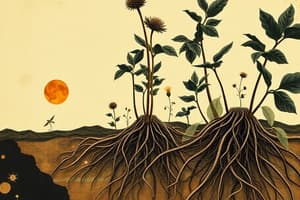Podcast
Questions and Answers
What is the primary characteristic that distinguishes plants from animals?
What is the primary characteristic that distinguishes plants from animals?
Which group of plants is characterized by exposed seeds and no flowers?
Which group of plants is characterized by exposed seeds and no flowers?
What is the term for the change in living things over time?
What is the term for the change in living things over time?
Who are the two scientists credited with developing the theory of evolution by natural selection?
Who are the two scientists credited with developing the theory of evolution by natural selection?
Signup and view all the answers
What is the term for the remains of ancient organisms preserved in rock?
What is the term for the remains of ancient organisms preserved in rock?
Signup and view all the answers
What is unique about the size of viruses?
What is unique about the size of viruses?
Signup and view all the answers
Which of the following is NOT a characteristic of lower plants?
Which of the following is NOT a characteristic of lower plants?
Signup and view all the answers
What is the term for organisms that inhabit the earth?
What is the term for organisms that inhabit the earth?
Signup and view all the answers
What is the main characteristic that distinguishes terrestrial plants from their aquatic ancestors?
What is the main characteristic that distinguishes terrestrial plants from their aquatic ancestors?
Signup and view all the answers
What is the function of the cell fibres in a virus?
What is the function of the cell fibres in a virus?
Signup and view all the answers
What is the difference between lytic and lysogenic relationships between viruses and bacteria?
What is the difference between lytic and lysogenic relationships between viruses and bacteria?
Signup and view all the answers
What is the primary function of chlorophylls a and b in plant cells?
What is the primary function of chlorophylls a and b in plant cells?
Signup and view all the answers
Why do plant gametes need to be protected from desiccation?
Why do plant gametes need to be protected from desiccation?
Signup and view all the answers
What is the function of the cuticle in aerial parts of plants?
What is the function of the cuticle in aerial parts of plants?
Signup and view all the answers
What is the term for viruses that attack bacteria?
What is the term for viruses that attack bacteria?
Signup and view all the answers
What is the characteristic that defines plants as autotrophs?
What is the characteristic that defines plants as autotrophs?
Signup and view all the answers
Study Notes
Plant Characteristics
- Plants are distinguished from animals by the presence of chlorophylls
- Some lower plants can move using appendages like flagella
Types of Plants
- Lower plants (cryptogamic):
- Non-seed bearing
- Lack vascular bundles
- Majority not segmented into leaves, stem, and roots
- Examples: viruses, algae, lichen, bryophytes, and pteridophytes
- Higher plants (phanerogams):
- Seed bearing
- Have a vascular system
- Extensive and efficient root system and stems
- Examples: gymnosperms and angiosperms
- Gymnosperms:
- Exposed seeds
- No flowers
- Majority are exotic/foreign
- Angiosperms:
- Flowering plants
- Common in our environment
Evolution
- Change in living things over time is known as evolution
- Evolution is a constant feature of the universe, applying to both living and non-living things
- Charles Darwin and Alfred Wallace independently developed the theory of evolution by natural selection
- Fossils provide information about the past and can be used to compare ancient and modern organisms
Viruses
- Exist in two forms: intra-cellular (living stage) and extra-cellular (non-living stage)
- Small organisms (2-20 μm) that can pass through filter pores
- Mostly pathogenic with no benefits to humans or plants
- Named by the diseases they cause (e.g., Tobacco Mosaic Virus, Human Immuno Virus)
- Consist of an outer protein coat and inner core (DNA or RNA, but not both)
Virus-Bacteria Relationship
- Lytic relationship: harmful or virulent, causing harm or death to host cells
- Lysogenic relationship: safer, with no harm or death to host cells
Plant Characteristics (continued)
- Plants are multicellular eukaryotes that are photosynthetic autotrophs
- Originated in water but are essentially terrestrial
- Aerial parts are coated with cuticle to prevent desiccation
- Stomata are developed for gaseous exchange
- Share functions with green algae, including photosynthesis
- Contain chloroplasts with chlorophylls a and b, and carotenoids
- Cell walls are composed of cellulose and carbohydrates are stored as starch
- Reproductive apparatus changed with movement to land, with gametes produced within gametangia and protected from desiccation
Studying That Suits You
Use AI to generate personalized quizzes and flashcards to suit your learning preferences.
Description
Learn about the key differences between plants and animals, and explore the characteristics of lower and higher plants, including their structure and examples.





